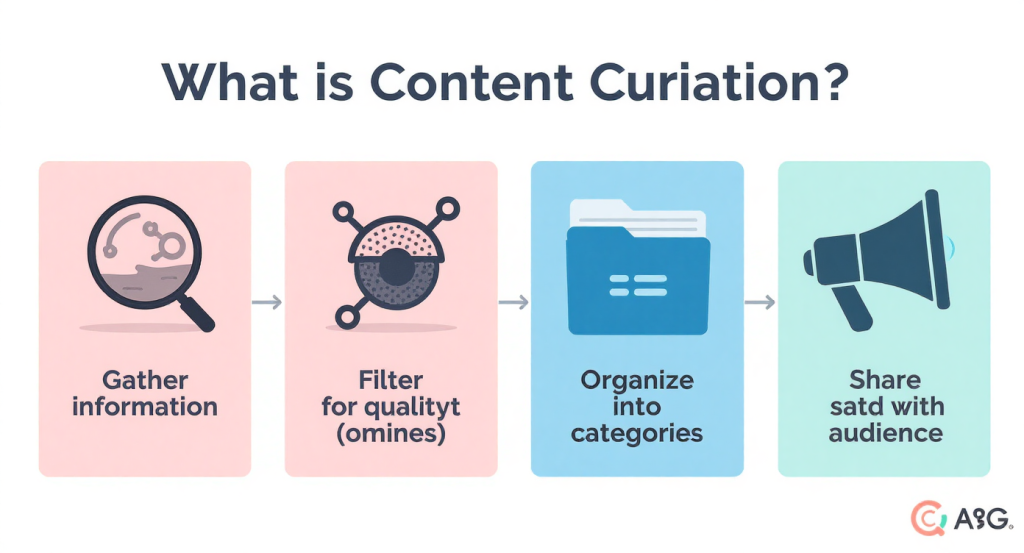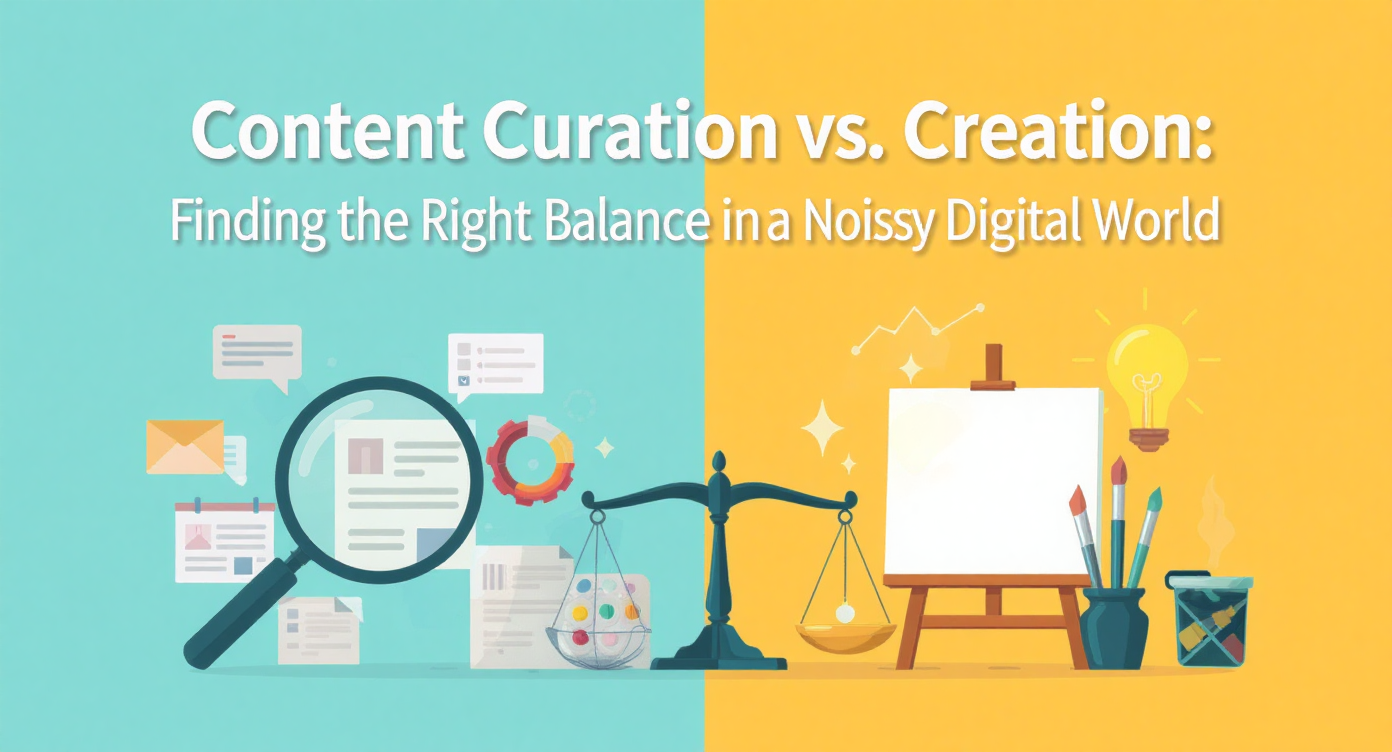Quality is king in the never-ending ocean of digital content, though not all materials wear the same crown! Marketers, entrepreneurs, influencers, and companies alike must rise above the noise if they want to be noticed; merely posting words on a page or screen isn’t enough. It requires strategy, authenticity , and value. And here is the magical place where two super effective tactics meet: content curation vs content creation. Knowing this and when to use one or the other can take your content game from being just good to unforgettable.
What Is Content Creation?

Content creation is the creation of original content from nothing. This can include writing blog articles, recording podcasts, sharing videos, creating infographics, or posting social media updates that help support your brand’s voice, knowledge, and POV. It’s an investment in thought leadership, creativity, and trust.
You aren’t a spectator when you create something; you’re making something that wasn’t there before. Whether it’s a thoughtful analysis, a funny video, or a personal opinion piece, you’re not just giving of yourself to your audience; you’re providing them with an emotional reason to engage further with you.
What Is Content Curation?

12 Content Curation. Most of the time, it is best to slow down and relate to the lifestyle of the group that you are trying to reach. Target a variety of audiences in different ways. Accept that making mistakes is a part of the new world of social media. Instead of building content from scratch, you highlight content others have written. It’s a content strategy that respects your audience’s time and demonstrates your ability to figure out what is worthy, timely, and helpful.
Curation is not just resending a link or re-tweeting. From there, it is curating your hot content, providing insights or context, and making it applicable to your community. Consider yourself a curator of a museum; you aren’t out there creating the stuff, but you are deciding what goes on display, how it is grouped, and what all of it says.
Content Creation vs. Curation: Key Differences
Creation and curation may at first seem interchangeable. Both put out content to their audiences, after all. However, the difference is in ownership and originality.
Creation involves:
- Full ownership of the material
- Custom insights and ideas
- Higher time and resource investment
- SEO benefits from original content
- Establishing authority and brand identity
Curation involves:
- Sharing third-party content
- Acting as an expert guide
- Less time to produce
- Helps fill content gaps
- Builds trust through association with reputable sources
Both have their spots in a robust digital strategy. Because as much as we’d like to create all of our content, the truth is that in the digital world, it’s impossible to do so… Especially when you’re fighting against the clock and operating with a shoestring budget.
The Value of Curating Content from Trusted Sources

In this age of misinformation and content overload, there is great value in curating from credible, trusted sources. It tells your audience that you are not just preaching but also listening. More importantly, you’re doing the noise filtering for them.
You give social media shares You give: Social shares And when you share high-quality content from a well-known authority within your niche, you give: A nod from someone who already knows their stuff within your niche You also give your site’s readers: The best information, from quality resources that you’re not affiliated with and that don’t cost them a dime And you get: simultaneous props and trust from that big name in the niche.
- Build credibility through association.
- Educate your audience with a diverse perspective.s
- Enhance your thought leadership by showing discernment. nt
- Stay relevant with trending insights without creating everything from scratch.
- Support community and collaboration among professionals and peers.
Nobody can know everything, all the time. Strategic Curation by amplifying voices worth hearing while still owning the narrative with your added commentary or framing.
Tools That Make Content Curation Easier

Good content curation is not just scrolling through Twitter or Google News and clicking. It needs tools that help you find, save, categorize, and schedule curated content. Fortunately, there are some amazing tools created exactly for this.
Feedly
Feedly is one of the best and most widely used RSS aggregators—it lets you keep up with blogs, news sites, YouTube channels, and newsletters in one location. You can categorize your feeds by topic, put your trusted sources on top, and see what’s trending in your field. The AI-assisted feature, Leo, even helps to filter out the noise by learning what you like over time.
With so many things on your plate, we know it can be tough to stay on top of the latest marketing trends (and practice what you learn, to boot!). Feedly makes it easy for even the busiest content managers and solo entrepreneurs to stay on top of the latest content with just a few simple clicks.
A pocket for saving articles, videos, and web pages for later. It’s ideal for content curation on the go. Whether on social media, reading on the web, or in forums, you can find great content and save it directly to Pocket to view later and share with the group via comments and threads.
Pocket’s tagging and organization systems make grouping saved content by theme or platform simple, so you don’t lose a crucial insight against an auto-scrolling feed.
Scoop.it
Scoop. It’s a professional content curation platform that allows you to find content and add your commentary as a curated post on your blog or social media. It’s a combination of discovery, collection, and distribution, so it’s great for marketers with some desired consistency in the myriad channels.
It even has analytics to help you measure engagement and determine which types of curated content your audience finds most compelling.
BuzzSumo
BuzzSumo finds the most shared, trending content for any topic. It’s great for curating current events or viral content, and tells you what kinds of articles get the most shares across social media platforms. It’s also a good way to keep an eye on what your competitors are doing and to identify influencer activity from which you might want to collaborate or draw inspiration.
Curata
Curata is an end-to-end content curation platform for businesses that leverages machine learning to help users discover and publish more content that “speaks” to their audience. It’s built for those centralizing content management for larger campaigns and features such as calendars, CRM, marketing platform integrations, and analytics.
Curata may be overkill for small teams or individual content creators. Still, it’s a goldmine for agencies and businesses that rely on their content to be efficiently organized, curated, and published.
When to Curate and When to Create
If you’re asking yourself whether to curate or create, it’s not either or it’s both. The trick is knowing when to do what.
Use content creation when:
- You’re launching a new product or service
- You want to establish thought leadership.
- You need content tailored to your audience’s unique challenge.s
- SEO is a priority
- You’re storytelling or building a brand voice.
Use content curation when:
- You want to maintain a consistent posting frequency
- You need to showcase community involvement or industry expertise.
- You’re short on time or resources.
- You want to add fresh perspectives without reinventing the wheel.
- You’re educating your audience on broader trends.
The most successful strategies combine the two. Think 60/40 or even 70/30 original, with the rest being curated insights to ensure your voice stays apace with the conversation. Still, your audience knows they’ll find your take on things exclusively when they come to you for updates.
The Ethics and Best Practices of Content Curation

Although curating content might seem easier and less time-consuming than creating it from scratch, it carries ethical responsibilities and professional standards. When you curate, you’re borrowing the hard work, research, and creativity of others. It’s crucial to handle that content with integrity and respect. Curators must:
- Always give credit to the original creators
- Link back to the source
- Don’t copy the whole content quote; summarize instead
- Comment or opinion: Add your insight
- Make it meaningful to whom you are addressing
This is not just about respecting copyright; it puts you in the expert’s chair, sharing a piece of your wisdom and allowing people to know who they’re dealing with.
Curating And Creating In Strategy
One of the most effective ways to blend content creation and curation is through a content repurposing strategy that allows you to maximize value from existing materials while incorporating fresh insights or curated additions. Repurposing saves time and ensures your content remains dynamic and multi-dimensional across platforms. For example, you might:
Create a blog post about new trends in your industry or field (curated roundup) in the top 5 articles about a topic.c
Produce a podcast responding to what’s trending in the news (curation + creation)
Share a quote (edited or unedited) with your commentary from a thought leader relevant to the topic.
Transform a curated industry report into a Twitter thread of insights
Starting from this curated content lets you post fun stuff, far more often (many times curated inspiration can even BE the end content), in a variety of low-lift fashion in a way that consistently enhances your audience’s experience.
Final Thoughts
And yet, in a digital age, attention is currency, and thoughtful content that enriches readers’ lives is your investment. Whether you are aggregating expert insights or expressing original ideas, what counts is value. No one in your audience can tell if you made it or found it. They care if it benefits them, touches them, or teaches them something they should understand.
Getting the balance between curating and creating leaves you with a strategy that won’t run out of steam and an agile, informed, and trustworthy brand. So, rather than relying on one, embrace both as part of your content toolkit and find that your influence will flourish.
